Vol. 21, December 2009
 2 responses
2 responses
Season’s Greetings from Around the Traps, our newsletter for members and black powder fun loving friends. The rifle in our picture and feature story should have made Christmas 1995 an unforgettable occasion. That didn’t quite work out. But today, the above snapshot by Kevin is your editor’s personal favourite of the month, and the accompanying lengthy story forwarded to Muzzleloader magazine explains why. Oh but first check out that beautiful stock timber!
Remington ER 1816 Commemorative Flintlock.
(It was the week before Christmas……)
Back in the mid nineties, whilst reading a popular Australian shooting publication, I came upon an eye-catching glossy advertisement for a flintlock rifle from Remington. “This limited edition replica will be produced for one year only, and available on special order through the Remington Custom Shop. Interested collectors and black powder shooters are encouraged to place orders early”
Wow, I thought, wouldn’t that be something special, as I looked at the colour picture of a fine long rifle. I read the complete advert again, and again. Later, when I had re-read the full ad for the umpteenth time, especially the line – “This is an authentic replica – lock, stock and barrel – of the first Remington rifle ever built” – I realised I was hooked, and knew that I had to have one of these Custom Shop specials.
The generic term “lock, stock & barrel” has come to be accepted as “the complete thing”, in this case encompassing those three components and everything else in a fine rifle, from the screws in the butt plate to the tip of the fore-end nose cap. So I just knew that Remington’s authentic replica flintlock was gonna be extraordinary special.
As we were already six months into the year, I cursed my late observation of the advertisement, and rushed to a helpful Melbourne suburbs gun dealer. He accepted my order with 10% deposit on the 1st July 1995, and would advise me just as soon as Remington’s Australian agents had shipping details. I settled down to wait it out.
Months passed, and my many phone enquiries all brought negative response. No gun and no word on it either. Nothing! 1995 became 1996 and I had grave misgivings about this order. Months later I was told that the Australian agents could not deliver, and I collected my deposit money – Oh, I was refunded alright yet most disappointed!
It was the week before Christmas ’96 when that same dealer phoned offering contact details of a guy in the States he said just might be able to help. Allowing for time zone difference, it was 2 am when I made my call, and within minutes learned that this U.S. mid-western dealer actually had six of these rifles in stock. Try to sleep on that!
It took a couple of days and a couple more late night calls to secure the transaction on one of those six rifles. Transfers and shipping arrangements were all organised by Christmas Eve and I was looking forward to a great New Year with a great new gun.
The rifle finally arrived in February ’97, some twenty months after first placing my original order. It looked great, all bright and shiny. I proudly took it home to get acquainted, and to read the accompanying literature and certificates containing the assurance that it had been made – “just the way old Eliphalet would have wanted it”.
A flint wrapped in leather was inserted tightly in the jaws, the frizzen closed, set the trigger, squeeze, and yep she sparks well. But wait, the trigger won’t reset. And that’s when my new troubles started! Cutting a long story short, examination revealed that the trigger sear was just a smidgeon too short and overridden by the triggers. My good friend, Bob Seip, an excellent tradesman toolmaker, came to the rescue, silver soldering and lengthening the sear bar about 1/8 of an inch.
On the firing line at the range, the gun was sparking and firing well, but then I noticed that closing the frizzen did not seal the pan, and a mere tilt of the rifle to get the priming away from the vent would cause all of the priming to fall out of the pan.
Cutting the long story again – examination revealed the periphery of the pan required a surface grind to level it. The frizzen itself was twisted slightly, and its axle hole was way off centre. Bob came to the rescue again with more of his toolmaker magic, for this lock and trigger set-up was decidedly not “the way old Eliphalet would have wanted it”.
But, I was forgiving of the Remington advertising spiel and could now enjoy shooting the piece without losing priming or having triggers snared. The barrel certainly shot as true as my tired old eyes could see. I even forgave Remington for the hex-slot screws through the ramrod thimbles into the barrel; well sort of – actually, I pretended not to notice!
Then one day the brass nose cap fell off into my hand. Hey, this thing just sits there held on with the slightest of spring tension. Surely old Eli would have had a rivet or a screw holding the brass cap to the maple?
A major disappointment was that the escutcheon plates were merely glued to the stock encompassing false “barrel” pins, yes, mere decorations serving absolutely no purpose. They do not secure the barrel in the stock in the traditional manner of original rifles! Some authentic replica! I still cannot believe there was anything so deceptive about any original rifle built by Eliphalet Remington.
The rifle never did match my expectations. In fact, I generally considered it an embarrassment to shoot it in company, but ten years passed before I finally spat the dummy over its tarnished pedigree. My good rendezvous friend Ian Convey, an aircraft instrument fitter by trade, offered to remake the rifle doing away with the hex head bolts through the thimbles, the fake escutcheon plates and pins and the dome headed brass patch box screws. This offer got me thinking of the Custom Shop gun I’d anticipated from Remington way back in 1995.
The lock selected was a John Twigg styled English lock by R.E. Davis. Unfortunately Ian had already made the iron furniture by the time the lock arrived, as there was a problem matching the Twigg to the original set triggers. After consultation with Ian it was decided he would build and fit a new single trigger, resulting in the trigger guard having just a little too much space in rear of the trigger. After a while I’ve gotten used to the aesthetics, and Ian’s single trigger has a light release which suits me just fine.
My original request had been for the poor boy look, with a grease-hole stock, no ram rod entry pipe of course, and without a nose cap. Ian heard that last bit and omitted the nose cap, but couldn’t stop himself from using a piece of scrap stock wood for a nice sliding patch box lid. After hand building some 30 rifles over the years, Ian’s experienced tone was recommending I reconsider excluding the ram rod entry pipe. I quickly agreed, and Ian hand made one matching the profile of the two front thimbles.
Being over 60 years of age, I had just one other request – to move that rear sight two foot further down the barrel. There was an alternative – to come up with a peep sight that would pass the criteria for the muzzleloader early season hunting in the U.S. While we don’t have such concessions here in Australia, it was felt that such a non- adjustable sight would be acceptable for all friendly range shoots, and a decided asset for any hunting here down-under, without transgressing into modern adjustable sights.
After a lengthy search of available books, magazines, internet and etc., Ian located an article he’d remembered from a 1994 Muzzleloader magazine on authentically styled peep sights. Ian’s interpretation utilizes a simple thumbscrew tapped into the tang. It blends easily into the overall pleasing lines of the rifle and allows fast acquisition of target with the ivory bead insert that Ian added to the front sight.
The original barrel was mirror-smooth in the bore with deep cut rifling, but it had several machining chatter marks on the top flats, so I asked Ian if the flats could be filed without losing the original name or serial numbers. Ian obliged once again and re-browned the barrel and all iron furniture to a nice plumb brown, before securing the barrel to the stock using genuine pins, as in the documented fashion of the era.
The barrel is now the only component retained from my original “replica” Remington. The Twigg lock by Davis throws great showers of sparks. The hand carved stock was given a little cast-off and enough wrist and forearm swell to sustain a life of knocks in the Aussie bush. The wood grain follows the wrist contours perfectly, and the natural light and dark contrasting colours flow in beautiful waves along the entire length. All iron furniture is one-off hand made and browned. Steel screw heads are all heat blued.
Thoughts of a poor boy rifle with grease hole were forgotten, and Ian’s finishing touches to the wooden patch box lid were a cast pewter finial, and to inlet five small studs representing the stars of the Southern Cross – a symbol denoting unity of cause, and the bonds of our primitive rendezvous club, the Southern Cross Free Trappers.
It’s rather hard to regard this rifle as a Remington any more, but at last it is something quite special; it’s now an honest and sturdy no-frills hunting rifle, and I like to think that finally it may be very close to Remington’s 1995 claim – “just the way old Eliphalet would have wanted it”.
Events 2010
2nd 3rd 4th 5th April. An Easter bunny and egg hunt at Bernard’s Cache, Caveat.
24th 25th & 26th April. Anzac w/end – serving seconds of rabbit pie at Bernard’s Cache.
12th –14th June. Queen’s Birthday long weekend – Winter Quarters at Bernard’s Cache.
17th – 20th September. Spring Rendezvous with friends at Beaver Creek, Whorouly. An extended single weekend – Friday 17th through to Monday 20th.
6th & 7th November. Melbourne Medieval Fayre and Tourney (MMFAT) at Berwick.
’Tis the Season…
Christmas time is extra special for families as we watch our children mature from year to year. We missed the kids at Rondyvoo this last September, so in this issue we’ve featured 2008 photos of our chillun’ having a great time doing kids stuff and enjoying rendezvous days. Plus we share a letter to all members from a friend in the USA. We hope you can take time to enjoy the read of our special Christmas bumper edition! And don’t forget to use the summer months to advantage revising gear or making new outfits for bigger and brighter rendezvous in 2010. A Merry Christmas to all.
Andrea forwarded this photo of John and William with Penny and the simple caption – Boys dog. It’s a favourite of mine too, but not because that’s my pooch waiting hopefully for scraps; it’s the memories of childhood it brings flooding back. Every boy dreams of camping and playing in the outdoors – tangled hair, a grubby face, real dirt behind the ears; socks, shirts and trousers that were all too briefly clean; pockets crammed with a folding knife and assorted treasures; thousands of questions to ask – that’s what kids do for a living! Every day is an adventure for boys and their dogs. Lewis and Clark were once young boys with that same zest for discovery.
Tattler
Mappo, aka Senator Festus T LaGarse, “running in Virginia, walking in Georgia” came across an abundance of prime beaver while “gallup-ing” among the northern hordes at MMFAT on Sunday 8th November. Keen to improve his polling he soon alerted the Trappers to the scores of beaver all hollering “Take me, take me”. This resulted in several Free Trappers and friends harvesting a haul of plews the like of Henry Frapp’s dying visions. What a coup for trappers representing the Club and for the disguised Frontier folk on that second hot day of the Medieval Fayre and Tourney.
Looking up Sam & Jake (A letter from Brad Randall, north Mississippi, thereabouts)
Howdy, I saw your website while looking up Sam & Jake Hawken on Google. I have to tell you, I’m impressed with your group. I suppose I had no idea that the folks Down Under even knew what Buck Skinners were all about. It looks to me; I will have to rethink the issue given what I saw on your web site. It looks really good and more importantly; it really looks and feels correct. I believe I would have fit right in well, except I suspect I talk funny to ya’ll being from the South and all.
I have been involved in smoke poles for over 35 years building and shooting them across the US, Germany, Canada and the UK. At last count I have built about 150 rifles and pistols. I built a Hawken gun for the American National Rifle Association. I have several in Europe, a few in Canada and the rest all over the US. I just came back from about 9 months in the UK and found a muzzleloading shotgun club there and had a great time knocking down clay birds. Well, and missing a bunch too but, it was a wonderful time.
I’ve done a lot of re-enacting of the American Revolution and American Civil War but, Buck Skinning is where my heart is. I spent about 20 years in the American Army and just don’t want to spend my fun time play soldier; especially when the guy in charge doesn’t know his head from a hole in the ground. I have also gotten to spend some time out in the Rockies going to Rendezvous, shooting, hunting elk, trout fishing and just standing around with my mouth hanging open in pure wonder at the beauty. I was out there one time in August, just outside of Yellowstone Park, and we got about 3 inches of snow. Yeah and I didn’t have my winter stuff either. Dang it was cold that night.
Anyway, I just wanted to say Howdy to you folks. I have attached a couple of pictures: one of my smiling face at a winter camp doing my best Davy Crockett, one of a flint lock smooth bore long gun I built and a flintlock pistol I have just finished.
Let me know how you folks are getting on. Maybe we can swap some, I was going to say lies but, let’s say stories. I don’t know ya’ll that well yet.
Oh, if you ever get to north Mississippi or anywhere near Memphis, TN, give me a call. I have a place to shoot and plenty of things to do it with. Also, one of the clubs I belong to usually has something going on most of the time.
Take care,
Brad Randall
Nov. 2009 Melbourne Medieval Fayre and Tourney (MMFAT) at Berwick.
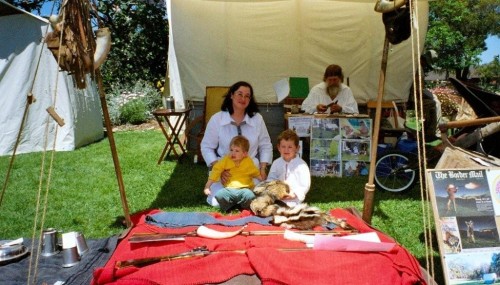
Lisa with Nicholas and Nathaniel at the Club’s display at MMFAT while at the right rear Bob examines a butcher’s knife.
MMFAT
What a heat wave – Melbourne in November enduring consecutive days of 35+ C. Summer heat hit us all far too suddenly and proved damned uncomfortable for many re-enactors normally dressing in wool jackets and medievals in chainmail. Never-the-less the Free Trappers together with Bojo Canvas Products put on a good display and received lots of attention, keen interest and many compliments all round.
Thanks to Bob Ellis, Ron Davis, Jim Walker and Paul Sly for manning the display and to all and sundry friends who continually utilised my George Washington stool.
More on Remington?
1816 Remington owners or enthusiasts are invited to comment on our leading article by using the form at the foot of this newsletter.
Additional photos of that refurbished Remington.
Spectacles
When we engage authenticity we continually see two main items that we hesitate to tackle, probably due to their single item cost. Footwear is often mentioned in our Tattler column as we try to help with suggestions. Shoes, boots and even moccasins can be expensive if we are serious about portrayals – but they need not be!
The second item is eyewear and this can also amount to a considerable outlay in dollars, but need not. The prescription lens is not the most expensive part. Locating period correct frames can be difficult, although several Sutlers do stock modern-made frames in the styles of 18th & 19th centuries at modest cost. Then it is simply a matter of getting your Optometrist to fit prescription lenses and you are there.
Some points to remember if you are ordering new lenses for your period frames.
- Bifocal spectacles were invented by Benjamin Franklin way back in 1760.
- Sunglasses arrived much later – in fact 1929. Polarizing lens followed in 1936.
All this means that bifocal lenses in period correct frames are quite kosher for our rendezvous’ even if your persona is of the French Indian Wars period (also known as the Seven Years War 1754-1763). Sadly, your modern-framed polarizing lenses, whether bifocal or not, are simply out-of-place. So, if you are wearing modern glasses please remember to remove them for photographs so as not to be a spectacle in print.
http://www.ideafinder.com/history/inventions/bifocals.htm
http://www.ideafinder.com/history/inventions/sunglasses.htm
Simple Fare – a Minimalist Approach.
To protect our pre 1840 theme I have been striving to eliminate as much as possible using modern foods and packaging that require vital 21st C storage to protect health. I try to carry only gear that a trapper could carry on packhorses. Thus the esky or ice-box, all large storage boxes, fire irons, cast iron cookware, enamel ware and camp furniture are slowly being eliminated from my kit. It means less to pack, less to carry and far less to store at home.
I’ve listed a few thoughts and achievements for your consideration – First up storage; Contrary to the no box rule I do have a wooden Hudson’s Bay trap-box which has been converted into a tuckerbox/camp kitchen. It is of a size that could be carried on a pack horse and has been modified internally for storage convenience.
Contained in the box are :- 3 steel plates,1 wooden bowl, 2 forks, 4 spoons (brass, wood & horn), 1 small steel spatula, 2 tin cups, 1 horn cup, 2 small chains & hooks for use on a fire tripod (wood) a small steel frypan, 3 tin billys which fit inside each other, a tin can of candles, a tin can with soap & scourer pad and tin cans containing the following foodstuffs- Oatmeal, flour, tea, coffee, sugar, powdered milk, sultanas, dried apricots, pasta, brown rice, dried peas corn & carrot mix and 2 square cork stoppered glass bottles containing tomato sauce and bear (olive) oil. There is also a salt horn and two others containing ground pepper and chilli powder.
I admit that some of these items and containers are not authentic for the pre 1840’s. This is a problem that I am slowly fixing; e.g. instant coffee replaced with coffee beans, powdered milk and pasta could be eliminated and the sugar replaced with either honey or maple syrup. I have utilised friction fit lid storage tins with a few slip lid tins when I can find them. Square tins such as for Twinings tea or Milo are ideal as they are vermin and moisture proof. Remove any paint from the tins by using paint stripper and scratch the contents name on the lid. Slip lid tins are more authentic but harder to come by, but these can sometimes be sourced at Opportunity shops.
Fresh fruit and vegetables such as apples, potatoes, onions and carrots all keep well without refrigeration as are easily stored in canvas bags hung out of reach of possums.
In the past I have utilised a canvas covered esky which has contained ice, frozen meat and frozen bread. My new challenge is to eliminate the esky and all refrigerated foods. I shall achieve this by carrying home made beef jerky, salamis and other cooked meats; all of which can be stored in calico bags. Such meat products can be re-cooked into various dishes such as stews. While hardly gourmet fare ample variety can still be enjoyed. Fresh game meat will be utilised when available, and instead of store-bought bakers bread I shall have to cook damper.
The worn-out cliché “if they had of had it, they would have used it” approach is just a tired and poor excuse dampening the true spirit of re-enactment. They simply didn’t have Winnebago’s with refrigerators, TV and CD radios – these things ain’t fun!
“Don’t ya wanna have fun no more?”
Ian Convey
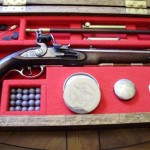
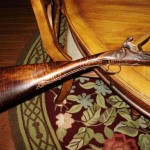
Fabulous recently completed cased pistol made by Brad Randall and the beautiful butt stock and lock of an earlier made fowling piece also by Brad. (see Brad’s letter above)
Brad says his blackpowder re-enacting club is similar to ours and Aussie Trappers can look them up on their website at www.hatchierunlongrifles.com

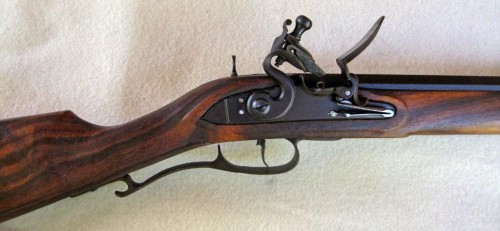

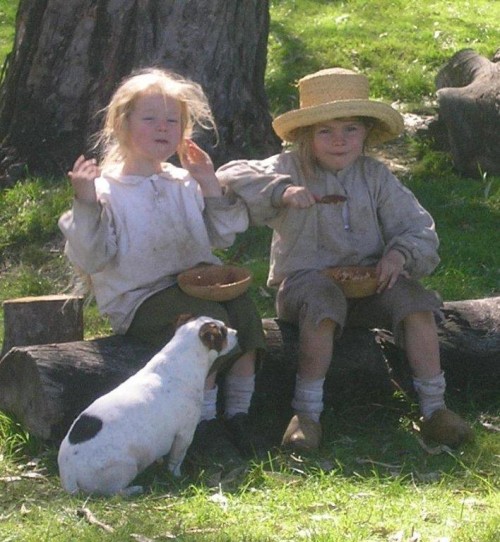
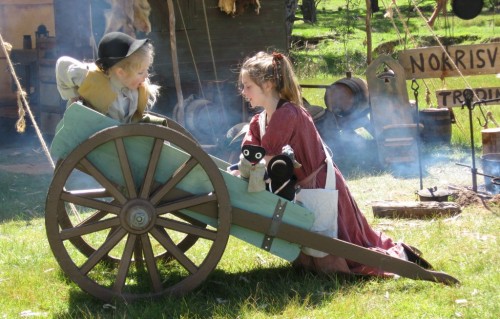
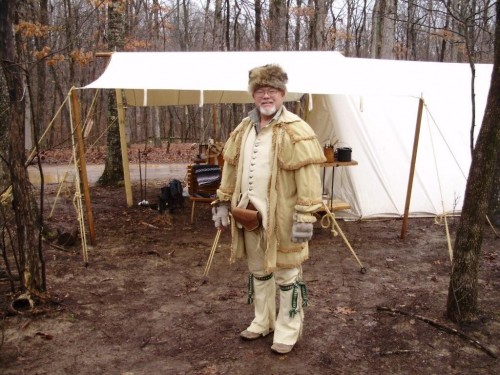
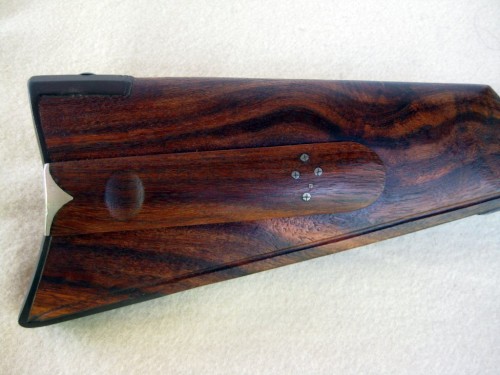

I want to jump in on this conversation. I am responsible for manufacturing the locks on the Remington 1816. The lock problem is best described as follows; we made the parts for the Hatfield Gun Company which is now out of business. What we supplied them was the components with some machining but no finishing and no heat treat. Ted Hatfield was responsible for the gunsmithing (heat treat, finishing, fitting, etc.) and final assembly of the lock parts. The problem came when Hatfield hired prisoners from the local jail, on work furlough, to do the assembly and finishing of the locks and rifle stocks. There was 3500 guns made. Hatfield said he didn’t figure anyone would shoot them so he did not put much effort into the lock and only concerned himself with the cosmetics of the gun. He soon found out how wrong he was. These guns came through the custom shop and most of the buyers did want to shoot them. This was a very large contract for Hatfield and a great opportunity and he squandered it away.
I do have plenty of parts for these guns, lock plate, frizzen, pan, hammer, tumbler, sear, etc. The are machined, NOT heat treated or finished. Contact us if we can be of some help. Mike @ 785-771-2100
Hello Mike,
Firstly, let me thank you for your response and I do apologise for the lengthy delay in acknowledgment.
I only read your comments yesterday and it was with much excitement as all other attempts to get some history of the 1816 repro project had drawn blanks – including approach direct to Remington. The Australian distributors for Remington were no help either. Your comments have answered many tired old questions that have irked me for many years. Web forums have suggested it and friends and I had suspected the Hatfield connection due to similarities with that company’s squirrel rifles, some of which have reached us Down Under. However, it was a revelation to read your lines about the “hired” help circumstances. Why Hatfield should think no-one would want to use the guns is beyond me, but I concede it a mindset that would foster shoddy assembly hidden behind a polished exterior.
You may have read my follow-up story in Vol 23 Around the Traps where the rifle is given a pet name – that of McCoy! This name does now seem most appropriate given my twisted sense of humour. No doubt some folks will feel that I have destroyed a collectable and maybe so, but I will always feel disappointed that the rifle never lived up to the Remington sales/merchandising claims. I’m not into collecting fakes! It seems unlikely that any of that figure of 3500 guns ever saw the inside of a “Remington” custom shop. Perhaps all Remington custom shop guns are what we would call jobbers here in Australia?
That said, the barrel still bears the proud Remington name and I have complete satisfaction with its performance. May I ask if you would happen to know what company produced the barrels for Remington?
Finally I really do appreciate your taking the time to respond and thank you again for these most enlightening details.
Sincerely
John (Chook) Fowler